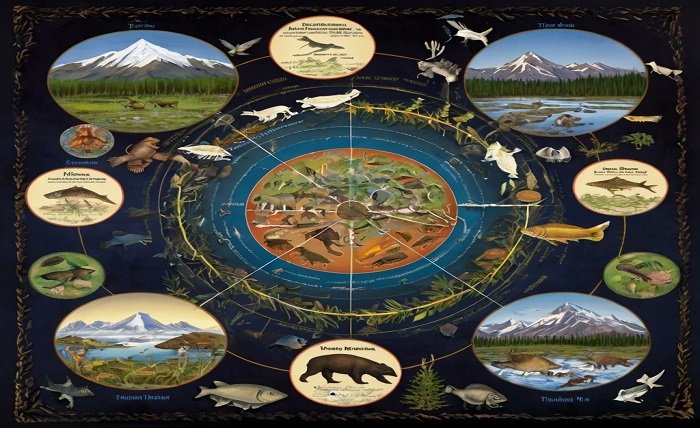Tundra food web: At first glance, the vast and frigid tundra biome may appear dead and desolate. But behind the frosty surface is a thriving, intricate food web. This essay explores the intriguing world of the tundra food chain, highlighting the fragile balance of life in one of the harshest habitats on Earth.
Primary Producers as the Foundation

The primary producers are at the base of the tundra food web. These include hardy moss, lichen, grass, and small shrub species that have evolved to withstand subfreezing temperatures and deficient soil nutrients. These plants serve as the base of the food chain, providing sustenance for a wide variety of herbivores by converting sunlight into energy through photosynthesis.
Herbivores: The Main Food Sources
By consuming the primary producers, herbivores play a vital role in the tundra food web. Caribou, musk oxen, lemmings, and arctic hares are examples of common tundra herbivores. These animals have evolved special adaptations, such as thick coats and fat layers, to help them withstand the bitter cold and effectively graze on the meager plants.
Small Carnivores: Unimportant Buyers
Small carnivores that feed on herbivores are the tundra’s secondary consumers. The snowy owl and the Arctic fox are two well-known examples. To find their prey, which is frequently elusive and well-camouflaged in a wintry environment, these predators must use their acute senses and cunning. Hunting success is essential for managing herbivore populations and preserving ecological balance.
Apex Predators are the top hunters in the tundra food web
Apex predators, like arctic wolves and polar bears, are at the top of the tundra food web. With no natural adversaries, these ferocious hunters are essential in controlling the numbers of smaller predators and herbivores. Their presence keeps the environment as a whole stable and healthy.
Decomposers are nature’s recycling agents
To decompose dead organic matter and replenish the soil with nutrients, decomposers such as bacteria, fungi, and detritivores are necessary. These organisms must contend with the frigid temperatures of the tundra, which slow down the pace of decomposition. Despite this, they are critical to the cycling of nutrients and plant growth, which maintains the entire food web.
Seasonal Dynamics: Managing Variations
The food web on the tundra is extremely dynamic and experiences notable seasonal fluctuations. In the short summer, sunshine causes a flurry of plant development, which in turn supplies plenty of food for herbivores and the predators that hunt them. The food web shrinks in the winter when a large number of animals move or hibernate, and the ecosystem depends on the ability of its species to withstand the severe weather.
Impact of Humanity: Difficulties and Preservation
Extremely dangerous human activities include industrial growth and climate change, which upset the fragile equilibrium of the tundra food web. Rising temperatures cause habitat loss and changes in species distribution. To preserve this special ecosystem and guarantee the survival of its complex food web and the wide range of species it supports, conservation measures are essential.
In summary
The Arctic food web is an example of how resilient and adaptable life can be in harsh conditions. Every organism, from the tiniest moss to the most powerful polar bear, is essential to preserving the equilibrium of this delicate environment. Maintaining biodiversity and our world’s health depends on our ability to understand and safeguard the tundra food chain.
FAQ
What are the tundra’s main producers? In the tundra, grasses, lichens, mosses, and tiny shrubs are the main food sources. Forming the base of the food chain, these plants have adapted to the frigid environment and nutrient-poor soils.
Which species are the primary consumers in the tundra food chain? Herbivores that consume the tundra’s flora, such as musk oxen, caribou, arctic hares, and lemmings, are the main consumers in the region.
What role do decomposers play in the tundra’s food web? Decomposers, such as fungi, bacteria, and detritivores, break down dead organic debris to replenish soil nutrients and promote plant growth, both crucial for the survival of the tundra food web.

